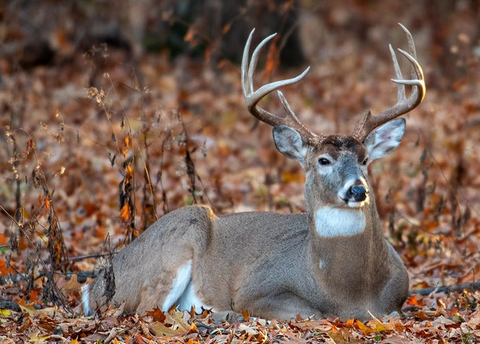Grow Big Deer Antlers
Antlers on deer are an interesting phenomena and have been fascinating people for ages. The annual cycle of growing, carrying, shedding and growing antlers again is more complicated than it looks. The antler growing cycle is a process that lasts about 10-months. It starts in March or April with pedicle development and ends in January or February when antlers are shed. The months of the year can be slightly different depending on where you live… Antler growth takes place in the tips of the antlers. As antlers grow, blood is circulated from the pedicle to the tips. The growing antler is a soft cartilage type tissue that is very delicate. Antlers are covered by velvet during growth, which contain many blood vessels and nerve endings. This network of blood vessels and nerves is necessary to transport the nutrients to the rapidly growing antler. Antler growth accelerates in June and July when antlers can grow a ½ inch to 1 inch per day. During the antler growth period when the antlers are encased in velvet, antlers are 20% dry matter, 80% crude protein, 22% calcium and 11% phosphorus. Between the end of July and the middle of August all points can probably be seen but some tine elongation may still take place.
When Are Buck Antlers The Biggest
In September the velvet subsequently dries up and begins to come off. Occasionally, bucks rub their antlers against brush to aid in the velvet removal. In this process, soft tissue is converted directly to bone by the deposition of minerals (mineralization) within the matrix of cartilage and blood vessels in the developing antlers. Mature polished antlers are 60% dry matter, 40% crude protein, 25 to 40% calcium and 19% phosphorus. In the whitetail deer this process is driven by photo period. When the days start to lengthen, the pineal gland in the brain notices the change and signals the pituitary to produce more of the hormone testosterone. Testicle circumference is increased and serum testosterone increases. More mature bucks will start to “muscle up”. In response to rising testosterone levels and testicular volume, antlers harden through calcification. Testosterone levels peak at the height of the rut and decrease rapidly into January. This drop in testosterone is why bucks shed their antlers. Muscle tone will also decrease and bucks will deposit more fat as an energy store for winter. Mature polished antlers can remain from the beginning of October thru February. Bucks will then shed their antlers and the process will start over again.

What Makes Deer Grow Big Antlers
Three major factors that determine antler size are:
- Age of the Buck
- Genetics of the Deer
- Deer Diet and Nutrition
A buck will not reach maximum antler size unless he has the genetics, is a healthy mature buck greater than five years old and has consumed the nutrients needed to achieve his genetic potential. Hunters and landowners have some control over these factors as they manage hunting areas. They can start by providing as near to optimum nutrition for the deer as possible. Antler growth from pedicle development to velvet shedding takes about 100 days on average, but feeding for antler growth is a 365-day a year job. In March and April, as pedicle development begins the buck needs amino acids from protein and minerals. These can come from the diet the buck is consuming. During antler growth from pedicle to the forked antler stage the buck pulls amino acids from the diet consumed, but minerals start to come from bone reserves.
During the rapid growth phase of antler development, late June through mid August the buck can’t consume enough amino acids or minerals to meet the maximum possible antler growth rate so the buck has to pull from bone and body reserves to do this. If there aren’t ample reserves to pull from, you can forget maximum antler production. Poor reserves mean that the main beam could have a smaller diameter, points could be reduced in size, or number of points off the main beam could be reduced. By the end of August or September when antler growth is done and velvet is shed, antler growth— and hence nutrient demand for their growth—is also done.
Are Deer Antlers The Same Size Every Year
Although this year’s antlers are what they are, in the fall the buck starts to build for the next set of antlers. He needs to keep body condition up to help get through the rut in good condition. During post rut the buck needs a well balanced diet to ensure restored bone mass, a deposit of minerals for next summer’s antler growth, restored body mass and rebuilding the amino acid pool used to support antler growth for the following year. Mature whitetail deer will sometimes go days during the rut without eating and can lose up to 30% of their body weight due to the stress of rutting activity. Post-rut stress is responsible for more death loss in mature deer than anything, simply due to the fact that they are run down and typically have very low quality forage available to replenish body reserves.
How To Increase Deer Antler Size
Bucks that are still growing or trying to replenish body reserves in late spring and summer will not grow the antlers that they have the genetic potential for if they are still trying to restore body condition.
Antler growth is a year round job. Do your research and pick your nutrition solutions wisely. Each day of growth adds up to those amazing racks, so get started early this year with a solid program that will prove superior results. Deer with great potential deserve the best nutrition possible.

